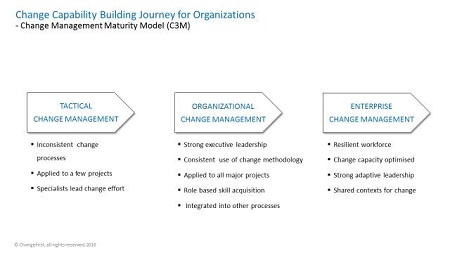Blog - How Organizations Prepare Themselves for Continuous Change
By David Miller, CEO and Founder Changefirst

A few years ago a publisher, Kogan Page, approached Changefirst to write a book about change management in the 21st Century. This project has evolved into a book that is being launched around the world, this April 2016, called Enterprise Change Management. Kogan Page, like us, saw that the waves of change and disruption in the business environment meant that organizations had to develop the capabilities to manage overlapping and continuous major changes.
More about Organizational Disruption
Fortune magazine reported in The War On Big Food that due to changing consumer demands the top 25 U.S. food and beverage companies have lost an equivalent of $18 billion in market share since 2009. It’s not just the obvious candidates who are under-going change. Even long standing incumbents in industries which you would think are immune from disruption are facing change.
An article in the Financial Times
Disrupters bring destruction and opportunity, December 2014 identified seven major industries that have been significantly disrupted in the past few years. They are technology, retail, transport, banks, real estate, media and telecoms. All of these businesses had a powerful imperative to change quickly. Long-established and entrenched ways of working can be quickly disrupted. Companies like Uber, Amazon or Apple are disrupting long established industries. They are what
Clayton M. Christensen called
disruptive innovation.
A disruptive innovation is one that creates a new market or disrupts an existing market. It describes innovations that improve a product or service in ways that the market does not expect. Typically, initially by designing for a different set of consumers in a new market and then later by lowering prices in the existing market. And, it’s not just the private sector. Services provided by the State such as health care, defence, transport are being affected by new technologies and different modes of execution designed to speed up delivery and reduce cost.
What Happens When Organizations Can’t Respond
Organizations who can’t respond fast enough and effectively enough in these conditions tend to suffer badly. We identify a “Change Gap” that opens up between what organizations need to implement and what they can actually implement. This can have disastrous consequences for shareholders, customers and employees. For example: organizations can’t keep up with more agile competitors, important public services are delivered late or not at all, employees become fatigued and dis-engaged, business performance deteriorates rapidly and when it does, recovery can be almost impossible.
Closing the Gap
So, what’s to be done? We identified four stages of change maturity and only the two highest, listed below, can give organizations any comfort. These are:
So, what’s to be done? We identified four stages of change maturity and only the two highest, listed below, can give organizations any comfort. These are:
- Organizational Change Management. This requires the ability to deliver individual projects or programs through a consistent and effective change management process, change management toolkit and change management training. This - on its own - is not a simple task for many organizations to achieve. The sheer effort required to build consistent capabilities can be daunting to under-performing enterprises.
- Enterprise Change Management. This takes the organization to a new, higher level. This is needed where the level of change is so disruptive that organizations need to take make change capability building part of their DNA. They need to create one of the key building blocks for agility. They do this by proactively managing their change capacity, building a resilient workforce and developing more adaptive forms of leadership. They are in place where just being great at Organizational Change Management is not good enough. The danger is the organization sinks under the weight of the change.

What will the book tell you?
In the book we review the Change Management Maturity Model (C3M) model in depth. Based on research on change performance from over 300 organizations and insights from one of the world’s biggest change management databases we help you diagnose the root causes of any gaps in organizational change performance, manage the overall demand for change and create the building blocks for successful continuous change in your organization. This book introduces five core capabilities – adaptive leadership; executing single changes effectively; managing the demand for change; developing a resilient workforce and creating the context for successful change. Frameworks, processes and tools help readers assess change capabilities and then create a strategy to close the change gap and improve performance in their organization.
To order your advanced copy go to Amazon or if you want a discussion about the ideas behind the book contact us at info@changefirst.com.
About Changefirst
Changefirst is a recognised global leader in change management solutions providing businesses with the change management methodology, tools and education to implement change successfully.
Our proven PCI® “People-Centered Implementation” methodology centers on employee engagement and applying a continuous change management approach to deliver successful change and sustain competitive advantage.
Setting us apart from the rest is “e-change®” our revolutionary, cloud based change management platform providing a cost effect means for businesses to build scalable capabilities and implement robust change processes. “e-change®” offers all the change tools, on-demand education, diagnostics and planning resources to support change from beginning to end.
Leading the way in change management for over 20 years, Changefirst has successfully trained over 20,000 people, in 175 organisations and 45 countries. They also have one of the largest global Organisational Change Management research and assessment databases enabling clients to benchmark their change performance.
For more information please contact us.


Leave a comment